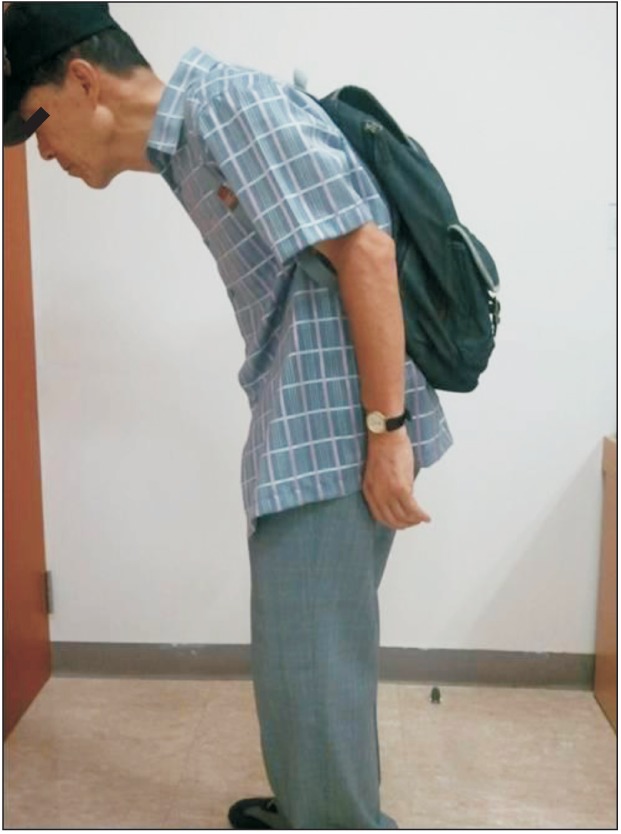Ann Rehabil Med.
2015 Feb;39(1):128-132. 10.5535/arm.2015.39.1.128.
Correction of Camptocormia Using a Cruciform Anterior Spinal Hyperextension Brace and Back Extensor Strengthening Exercise in a Patient With Parkinson Disease
- Affiliations
-
- 1Department of Rehabilitation Medicine and Research Institute of Rehabilitation Medicine, Yonsei University College of Medicine, Seoul, Korea.
- 2Department of Physical Medicine and Rehabilitation, National Health Insurance Service Ilsan Hospital, Goyang, Korea. rekhs@nhimc.or.kr
- KMID: 2273029
- DOI: http://doi.org/10.5535/arm.2015.39.1.128
Abstract
- Parkinson disease, one of the most common neurodegenerative diseases, is characterized by cardinal motor features including bradykinesia, rigidity, resting tremor, postural instability, freezing gait, and fatigue. Of these, postural instability in the form of hyperflexion of the thoracolumbar spine upon standing and walking that disappears on recumbent positioning is called camptocormia. Many different trials have been conducted on the treatment of camptocormia, including physiotherapy, corsets, medications, and deep brain stimulation. However, there is insufficient evidence as to which treatment modality is the most valid in terms of effectiveness, cost, safety, and patient satisfaction. In this study, we present a patient whose symptom of camptocormia was effectively resolved using a cruciform anterior spinal hyperextension (CASH) brace and back extensor strengthening exercise which was modified through follow-ups based on a short-term outpatient setting for proper application with minimal discomfort. The patient was satisfied with the amount of correction provided by the brace and exercise.
Keyword
MeSH Terms
Figure
Cited by 1 articles
-
Back Extensor Strengthening Exercise and Backpack Wearing Treatment for Camptocormia in Parkinson's Disease: A Retrospective Pilot Study
Kun Hee Lee, Jong Moon Kim, Hyoung Seop Kim
Ann Rehabil Med. 2017;41(4):677-685. doi: 10.5535/arm.2017.41.4.677.
Reference
-
1. Doherty KM, van de Warrenburg BP, Peralta MC, Silveira-Moriyama L, Azulay JP, Gershanik OS, et al. Postural deformities in Parkinson's disease. Lancet Neurol. 2011; 10:538–549. PMID: 21514890.
Article2. Askmark H, Eeg-Olofsson K, Johansson A, Nilsson P, Olsson Y, Aquilonius S. Parkinsonism and neck extensor myopathy: a new syndrome or coincidental findings? Arch Neurol. 2001; 58:232–237. PMID: 11176961.3. Schabitz WR, Glatz K, Schuhan C, Sommer C, Berger C, Schwaninger M, et al. Severe forward flexion of the trunk in Parkinson's disease: focal myopathy of the paraspinal muscles mimicking camptocormia. Mov Disord. 2003; 18:408–414. PMID: 12671947.4. Sakas DE, Panourias IG, Stavrinou LC, Boviatsis EJ, Themistocleous M, Stathis P, et al. Restoration of erect posture in idiopathic camptocormia by electrical stimulation of the globus pallidus internus. J Neurosurg. 2010; 113:1246–1250. PMID: 20380528.
Article5. Melamed E, Djaldetti R. Camptocormia in Parkinson's disease. J Neurol. 2006; 253(Suppl 7):VII14–VII16. PMID: 17131221.
Article6. Azher SN, Jankovic J. Camptocormia: pathogenesis, classification, and response to therapy. Neurology. 2005; 65:355–359. PMID: 16087897.
Article7. Pfeifer M, Begerow B, Minne HW. Effects of a new spinal orthosis on posture, trunk strength, and quality of life in women with postmenopausal osteoporosis: a randomized trial. Am J Phys Med Rehabil. 2004; 83:177–186. PMID: 15043351.8. Sinaki M, Brey RH, Hughes CA, Larson DR, Kaufman KR. Significant reduction in risk of falls and back pain in osteoporotic-kyphotic women through a Spinal Proprioceptive Extension Exercise Dynamic (SPEED) program. Mayo Clin Proc. 2005; 80:849–855. PMID: 16007888.
Article
- Full Text Links
- Actions
-
Cited
- CITED
-
- Close
- Share
- Similar articles
-
- Back Extensor Strengthening Exercise and Backpack Wearing Treatment for Camptocormia in Parkinson's Disease: A Retrospective Pilot Study
- Effect of Lumbar Extensor Strengthening in Chronic Low Back Pain Patients
- Comparisons of Spinal Stabilization Exercise and Lumbar Extensor Strengthening Exercise in Chronic Low Back Pain
- The Effect of Back Extensor Strengthening Exercise on Chronic Low Back Pain and Bone Mineral Density
- Multiple Spinal Revision Surgery in a Patient with Parkinson's Disease





